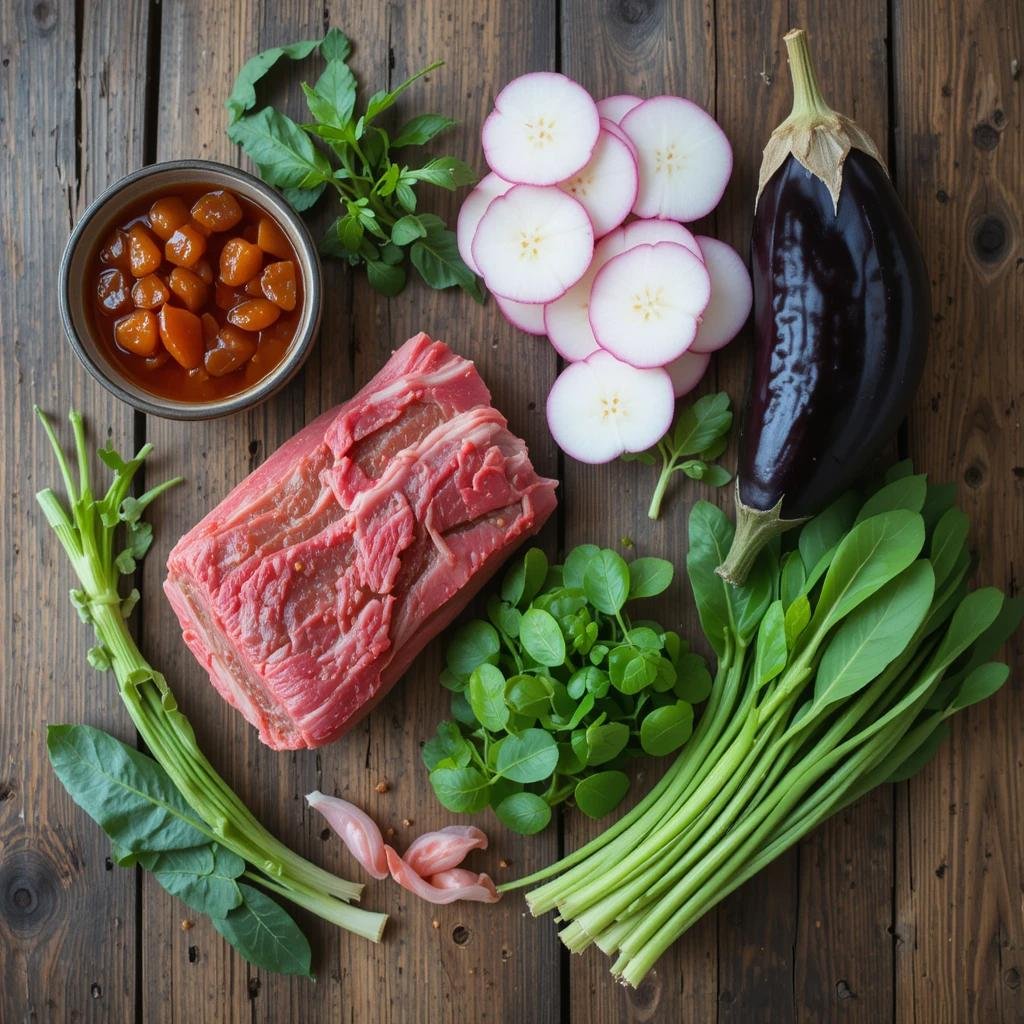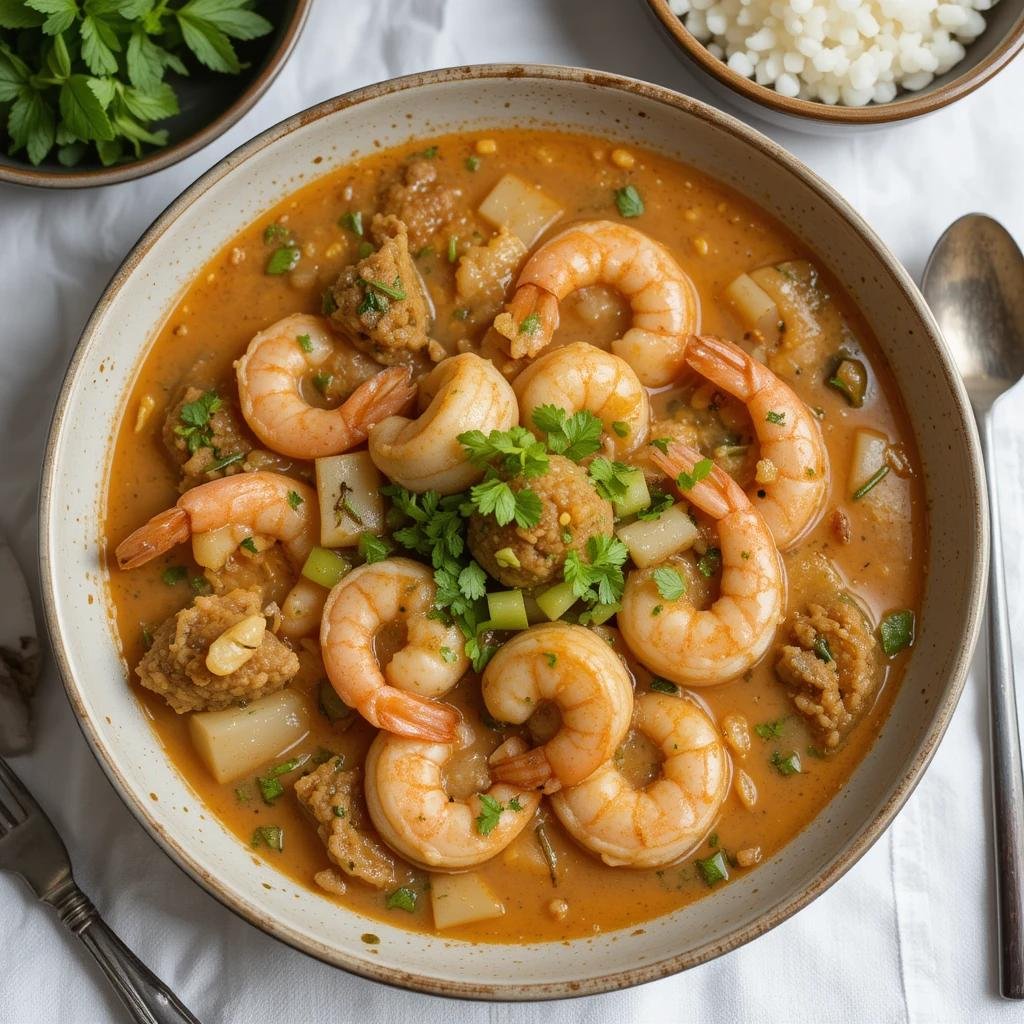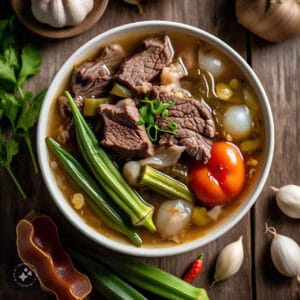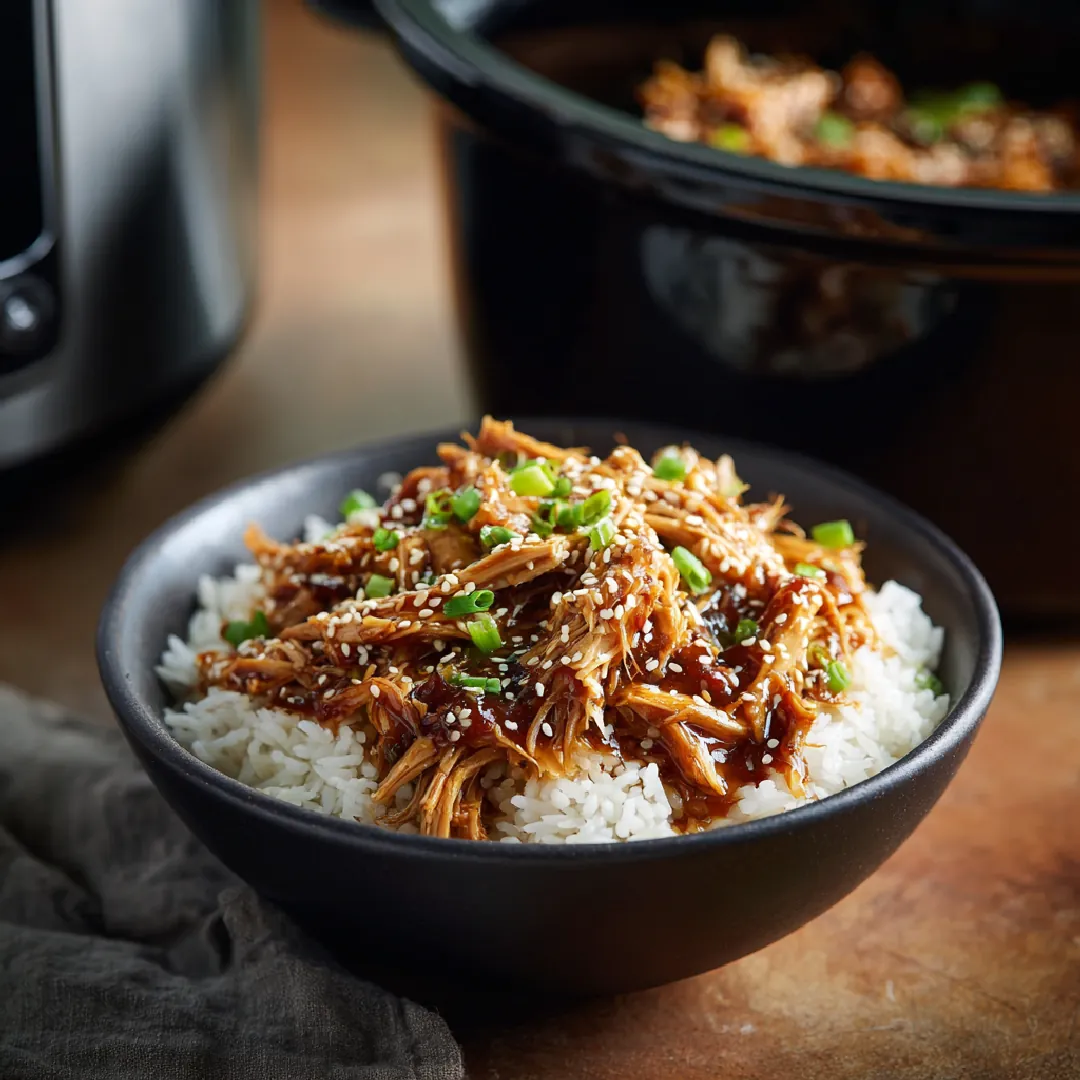Table of Contents
Filipino cuisine is known for its bold flavors and comforting dishes, and one dish that stands out is sinigang. This beloved Filipino sour soup combines savory proteins like pork, shrimp, or fish with fresh vegetables and a tangy tamarind broth, creating a harmonious blend of flavors. If you’re craving an authentic sinigang recipe, you’re in the right place—let’s dive into how to make this iconic dish at home.
But how exactly do you make sinigang at home? If you’re ready to dive into a flavorful adventure, let’s unravel the secrets to preparing an authentic sinigang recipe.
What Is Sinigang? An Overview of the Iconic Filipino Dish
Before we dive into the nitty-gritty of the recipe, let’s talk about what sinigang really is.
Sinigang is a traditional Filipino soup characterized by its sour broth. The dish often features proteins like pork, shrimp, or fish and is loaded with fresh vegetables. What makes it special? It’s the tamarind—or sometimes other souring agents like calamansi or green mango—that gives it that unmistakable tangy kick.
Imagine a rainy day, a steaming bowl of sinigang on the table, and the smell of simmering tamarind wafting through the kitchen. Comforting, right? That’s the essence of sinigang: cozy, hearty, and oh-so-flavorful.
The Origins and Cultural Significance of Sinigang
How Sinigang Reflects Filipino Heritage
Sinigang isn’t just food; it’s a story. Its origins can be traced back to early Filipino communities where cooking with fresh, local ingredients was the norm. Tamarind, a fruit that grows abundantly in the Philippines, became the cornerstone of this dish.
This dish also showcases the Filipino love for balance in flavor. Sour, savory, sometimes a hint of sweet—all these elements come together in one bowl. It’s not just about the taste; it’s a reflection of the Filipino way of life: resilient, resourceful, and warm.
“Sinigang is more than just a dish—it’s a warm hug from Filipino culture, inviting you to savor its simple yet profound flavors.”
Why Sinigang Recipe Is a Favorite Across Generations
Ask any Filipino, and they’ll tell you about a childhood memory involving sinigang. It’s the kind of dish that transcends time, bringing families together at the dining table.
What’s more, its versatility means there’s a version for everyone. Don’t eat pork? No problem—shrimp or fish make excellent substitutes. Want it spicier? Toss in a chili or two. This adaptability is why sinigang has stood the test of time.
Key Ingredients for an Authentic Sinigang Recipe
One thing to note: sinigang’s flavor lies in its fresh, quality ingredients. Let’s break down what you’ll need to make it just right.
Protein Choices

The protein you choose sets the tone for your sinigang. Beef sinigang is the most popular and gives the soup a hearty richness. Opt for cuts like ribs for maximum flavor.
If you prefer something lighter, shrimp (sinigang na hipon) or fish (sinigang na isda) are fantastic alternatives. Milkfish, tilapia, or snapper are common choices, each lending a unique twist to the broth.
Essential Vegetables for Sinigang
The vegetables in sinigang aren’t just for show—they play a vital role in its flavor profile. A classic lineup includes:
- Radish (labanos): Adds a mild sweetness.
- Water spinach (kangkong): Provides an earthy note.
- Eggplant (talong): Absorbs the broth’s tangy goodness.
- Okra: Brings a slightly slimy texture that thickens the soup.
- String beans: Adds crunch and freshness.
Feel free to experiment! Sinigang thrives on flexibility, so add what’s in season or what you have on hand.
Tamarind and Other Sour Flavorings Explained
Tamarind is the heart and soul of sinigang. You can use fresh tamarind pods, tamarind paste, or even instant tamarind seasoning mix for convenience.
Not a fan of tamarind? Calamansi, kamias (bilimbi fruit), and even unripe mango are great alternatives. The goal is to create a broth that makes you pucker—just a little.
Step-by-Step Guide for the Perfect Sinigang Recipe
Making sinigang is like crafting a symphony. Each step adds a layer of flavor that builds into a masterpiece.
Prepping Your Ingredients
Preparation is key. Start by washing your vegetables thoroughly and cutting them into bite-sized pieces. If you’re using pork, trim excess fat (but leave some for flavor!). For shrimp or fish, clean and devein as necessary.
“A well-prepped kitchen makes the cooking process smoother and the end result more satisfying.”
Sinigang Recipe: Techniques and Tips
- Boil the Protein: Begin by boiling your chosen protein in water until tender. Skim off any scum that rises to the surface to keep the broth clear.
- Add Tamarind: Once the meat is tender, add your tamarind or souring agent. Let it dissolve completely into the broth.
- Incorporate Vegetables: Start with the hardier veggies like radish and string beans. Add the leafy greens like kangkong last to prevent overcooking.
- Season to Taste: Add fish sauce (patis) for a deeper umami flavor and adjust the sourness as needed.
Common Mistakes to Avoid When Making Sinigang
- Overcooking the vegetables: No one likes mushy veggies. Keep an eye on your pot!
- Using the wrong protein: Certain cuts of meat can turn chewy if cooked too long. Choose tender cuts for the best results.
- Overpowering the sourness: While tangy is good, too much sourness can overwhelm the dish. Balance is key.
Variations of Sinigang: Exploring Different Styles
Sinigang isn’t a one-size-fits-all dish. Let’s explore some popular variations that bring unique twists to the table.

Sinigang na Hipon (Shrimp Sinigang)
Light and refreshing, this variation highlights the natural sweetness of shrimp. It’s a summer favorite that pairs beautifully with a side of rice.
Sinigang sa Miso (Miso Sinigang)
Adding miso paste to the broth elevates its flavor, giving it a creamy, umami-rich twist. It’s a must-try for adventurous eaters!
Health Benefits of Sinigang
What’s amazing about sinigang isn’t just its taste—it’s also surprisingly nutritious! Let’s dig into the health benefits of this Filipino classic and why it deserves a spot on your menu rotation.
Nutritional Profile of Sinigang Ingredients
Sinigang is a nutrient powerhouse thanks to its blend of protein, vegetables, and souring agents. Here’s what you’re getting in every bowl:
- Protein: Depending on your choice of pork, shrimp, or fish, sinigang offers a good dose of lean protein essential for muscle repair and overall health.
- Vegetables: Radish, spinach, and eggplant are rich in fiber, vitamins, and minerals. Spinach, in particular, is loaded with iron and antioxidants.
- Tamarind: Tamarind is a fantastic source of vitamin C, which supports the immune system and promotes healthy skin.
Together, these ingredients create a balanced dish that nourishes the body while tantalizing the taste buds.
Why Sinigang Is a Perfect Comfort Food
Sinigang’s warm broth and sour kick make it a go-to comfort food. It’s like a cozy blanket on a cold day!
The sourness isn’t just for flavor—it can stimulate digestion and even improve appetite. Plus, it’s relatively light, so you won’t feel overly stuffed after enjoying a hearty bowl.
“Sinigang isn’t just a meal; it’s a mood-booster in a bowl. Each spoonful feels like home.”
Troubleshooting Common Sinigang Problems
Cooking sinigang might seem straightforward, but like any dish, it comes with its challenges. Let’s tackle some common problems and how to fix them.
What to Do If the Soup Is Too Sour
Accidentally went heavy on the tamarind? Don’t worry—there’s an easy fix. Add a touch of sugar to balance the sourness or dilute the soup with more broth or water.
How to Fix Overcooked Vegetables
If your veggies have turned mushy, the best remedy is prevention. Add hard vegetables like radish earlier in the cooking process and leafy greens like spinach just before serving. If overcooking happens, enjoy the softened texture or repurpose the soup as a sauce for rice.
Making Sinigang When Tamarind Isn’t Available
No tamarind? No problem! Use alternative souring agents like calamansi, unripe mango, or even lemon juice. Each gives a slightly different flavor, but all will keep the spirit of sinigang alive.
Serving and Pairing Suggestions for Sinigang
Sinigang shines on its own, but pairing it with the right sides and drinks can elevate the meal even further.
Best Side Dishes to Serve with Sinigang
- Steamed Rice: This is non-negotiable. The fluffy texture of rice absorbs the tangy broth perfectly.
- Fried Fish or Tofu: A crispy side dish adds contrast to the soft textures in sinigang.
- Ensaladang Talong: A smoky eggplant salad complements sinigang’s sour notes beautifully.
Drinks That Complement Sinigang’s Flavor
Sinigang’s tangy and savory flavors pair well with refreshing beverages. Here are some great options:
- Calamansi Juice: Its citrusy sweetness echoes the tamarind’s flavor.
- Iced Tea: A classic pairing that cleanses the palate.
- Coconut Water: Light and hydrating, perfect for offsetting the richness of the broth.
“Pairing sinigang with the right side dishes and drinks is like finding the perfect harmony in a song—it just feels right.”
Mastering the Perfect Sinigang Recipe at Home
Now that you’re armed with the essentials, it’s time to perfect your sinigang-making skills.
Tips from Filipino Home Cooks
- Use Fresh Ingredients: Fresh tamarind and vegetables make a world of difference in flavor.
- Don’t Rush: Allow the broth to simmer long enough to extract the full flavor from the tamarind and meat.
- Taste As You Go: Sinigang’s flavor is highly personal—adjust the sourness and seasoning to suit your taste buds.
Regional Twists You Can Try
Different regions in the Philippines put their unique spin on sinigang. In Pampanga, they might add guava for a sweeter touch. In Ilocos, bagoong (fermented shrimp paste) is sometimes mixed in for an umami punch.
“Cooking sinigang is like painting a canvas—your ingredients are your colors, and your taste preferences guide your brushstrokes.”
Sinigang Recipe FAQ: Addressing Common Questions
Even the most seasoned cooks have questions about sinigang. Let’s clear up some of the most frequent queries.
Can Sinigang Be Made Vegetarian?
Absolutely! Simply skip the meat and double up on vegetables like mushrooms, tofu, and taro for a satisfying vegetarian version. For added depth, try using vegetable broth as the base.
How Long Can Sinigang Be Stored in the Refrigerator?
inigang keeps well for 2–3 days when stored in an airtight container in the fridge. Reheat gently to avoid overcooking the vegetables. Pro tip: The flavors deepen as it sits, making leftovers even more delicious!
Is Sinigang Spicy or Just Sour?
Traditionally, sinigang is more sour than spicy. However, you can add a chili or two for heat if that’s your thing! Sinigang is all about customization, so make it your own.
Conclusion: Celebrate Filipino Flavors with Sinigang
Sinigang is more than just a dish—it’s an experience, a tradition, and a celebration of Filipino flavors. Whether you’re cooking it for the first time or perfecting your 100th pot, the joy of making and sharing sinigang never gets old.
So, grab your tamarind, chop those veggies, and let the magic of sinigang fill your kitchen with love and warmth. Ready to give it a try? You won’t regret it.
You might also like What Seasoning Is Good for Rockfish?





